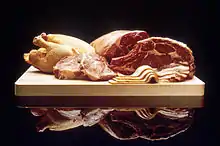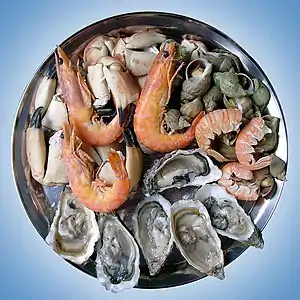Bacon
Bacon is a type of salt-cured pork[1] made from various cuts, typically from the pork belly or from the less fatty back cuts. It is eaten on its own, as a side dish (particularly in breakfasts), or used as a minor ingredient to flavour dishes (e.g., the club sandwich). Bacon is also used for barding and larding roasts, especially game, including venison and pheasant, and may also be used to insulate or flavour roast joints by being layered onto the meat. The word is derived from the Old High German Bahho, meaning "buttock", "ham" or "side of bacon", and is cognate with the Old French bacon.[2][3] It may also be distantly cognate with modern German Bauch, meaning "abdomen, belly". [4]
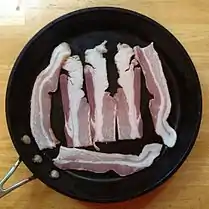
.jpg.webp)
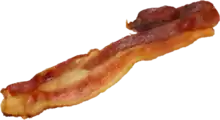 A strip of cooked side (streaky) bacon | |
| Type | cured pork |
|---|---|
| Main ingredients | salt-cured pork belly |
Meat from other animals, such as beef, lamb, chicken, goat, or turkey, may also be cut, cured, or otherwise prepared to resemble bacon, and may even be referred to as, for example, "turkey bacon".[5] Such use is common in areas with significant Jewish and Muslim populations as both religions prohibit the consumption of pork.[6] Vegetarian bacons such as "soy bacon" also exist.
Curing and smoking
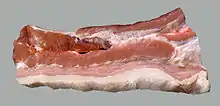
Historically, before the advent of cheap and widespread artificial refrigeration in the modern era, the curing of pork was necessary for the safe long-term preservation of meat. However, the flavor imparted to the meat by the various curing processes had become much prized, and although the curing process is in general no longer necessary in the developed world, it continues in wide use due to the flavor and other properties it imparts to the meat.
Bacon is cured through either a process of injecting it with or soaking it in brine, known as wet curing, or using plain crystal salt, known as dry curing.[1][7] Bacon brine has added curing ingredients, most notably nitrites or nitrates, which speed the curing and stabilize colour. Fresh bacon may then be dried for weeks or months in cold air, or it may be smoked or boiled.[1] Fresh and dried bacon are typically cooked before eating, often by pan frying. Boiled bacon is ready to eat, as is some smoked bacon, but they may be cooked further before eating. Differing flavours can be achieved by using various types of wood, or less common fuels such as corn cobs or peat. This process can take up to eighteen hours, depending on the intensity of the flavour desired. The Virginia Housewife (1824), thought to be one of the earliest American cookbooks, gives no indication that bacon is ever not smoked, though it gives no advice on flavouring, noting only that care should be taken lest the fire get too hot.[8] In early American history, the curing and smoking of bacon (like the making of sausage) seems to have been one of the few food-preparation processes not divided by gender.[9]
Bacon is distinguished from other salt-cured pork by differences in the cuts of meat used and in the brine or dry packing. Historically, the terms "ham" and "bacon" referred to different cuts of meat that were brined or packed identically, often together in the same barrel. Today, ham is defined as coming from the hind portion of the pig and brine specifically for curing ham includes a greater amount of sugar, while bacon is less sweet, though ingredients such as brown sugar or maple syrup are used for flavour. Bacon is similar to salt pork, which in modern times is often prepared from similar cuts, but salt pork is never smoked, and has a much higher salt content.[10]
For safety, bacon may be treated to prevent trichinosis,[11] caused by Trichinella, a parasitic roundworm which can be destroyed by heating, freezing, drying, or smoking.[12] Sodium polyphosphates, such as sodium triphosphate, may also be added to make the product easier to slice and to reduce spattering when the bacon is pan-fried.
Cuts
Varieties differ depending on the primal cut from which they are prepared.[10][1] Different cuts of pork are used for making bacon depending on local preferences.

- Side bacon, or streaky bacon, comes from the pork belly.[10][1] It has long alternating layers of fat and muscle running parallel to the rind.[10][13] This is the most common form of bacon in the United States.[10]

- Back bacon contains meat from the loin in the middle of the back of the pig.[10][14] It is a leaner cut, with less fat compared to side bacon.[1] Most bacon consumed in the United Kingdom and Ireland is back bacon.[10][15]
- Collar bacon is taken from the back of a pig near the head.[10][16]
- Cottage bacon is made from the lean meat from a boneless pork shoulder that is typically tied into an oval shape.[10]
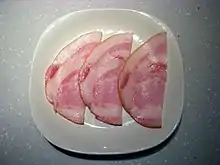
- Jowl bacon is cured and smoked cheeks of pork.[17] Guanciale is an Italian jowl bacon that is seasoned and dry cured but not smoked.
The inclusion of skin with a cut of bacon, known as the 'bacon rind',[18] varies, though is less common in the English-speaking world.
Around the world
Bacon is often served with eggs and sausages as part of a full breakfast.[19]
Australia and New Zealand
The most common form sold is middle bacon, which includes some of the streaky, fatty section of side bacon along with a portion of the loin of back bacon. In response to increasing consumer diet-consciousness, some supermarkets also offer the loin section only. This is sold as short cut bacon and is usually priced slightly higher than middle bacon. Both varieties are usually available with the rind removed.[20]
Canada
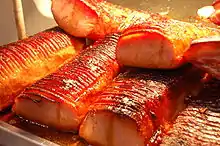
In Canada, the term bacon on its own typically refers to side bacon.[21] Canadian-style back bacon is a lean cut from the eye of the pork loin with little surrounding fat.[21] Peameal bacon is an unsmoked back bacon, wet-cured and coated in fine-ground cornmeal (historically, it was rolled in ground, dried peas);[21] it is popular in southern Ontario. Bacon is often eaten in breakfasts, such as with cooked eggs or pancakes. Maple syrup is often used as a flavouring while curing bacon in Canada.
Germany
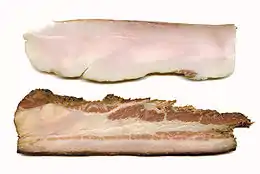
Some of the meanings of bacon overlap with the German-language term Speck. Germans use the term bacon explicitly for Frühstücksspeck ('breakfast Speck') which are cured or smoked pork slices. Traditional German cold cuts favor ham over bacon, however Wammerl (grilled pork belly) remains popular in Bavaria.
Small bacon cubes (called Grieben or Grammerln in Austria and southern Germany) have been a rather important ingredient of various southern German dishes. They are used for adding flavour to soups and salads and for Speck dumplings and various noodle and potato dishes. Instead of preparing them at home from larger slices, they have been sold ready made as convenience foods recently as Baconwürfel ("bacon cubes") in German retail stores.
Japan
In Japan, bacon (ベーコン)[22] is pronounced "bēkon". It is cured and smoked belly meat as in the US, and is sold in either regular or half-length sizes. Bacon in Japan is different from that in the US in that the meat is not sold raw, but is processed, precooked and has a ham-like consistency when cooked.[23] Uncured, sliced pork belly, known as bara (バラ), is very popular in Japan and is used in a variety of dishes (e.g. yakitori and yakiniku).
United Kingdom and Ireland
Back bacon is the most common form in the UK and Ireland, and is the usual meaning of the plain term "bacon". A thin slice of bacon is known as a rasher; about 70% of bacon is sold as rashers.[24] Heavily trimmed back cuts which consist of just the eye of meat, known as a medallion, are also available. All types may be unsmoked or smoked. The side cut normal in America is known as "streaky bacon",[25] and there is also a long cut, curving round on itself, known as "middle bacon", which is back bacon at one end, and streaky at the other, as well as less common cuts.[26] Bacon is also sold and served as joints, usually boiled, broiled or roast,[27] or in thicker slices called chops or steaks. These are usually eaten as part of other meals.[7]
Bacon may be cured in several ways, and may be smoked or unsmoked; unsmoked bacon is known as "green bacon".[7] Fried or grilled bacon rashers are included in the "traditional" full breakfast. Hot bacon sandwiches are a popular cafe dish in the UK and Ireland,[28] and is anecdotally recommended as a hangover cure.[29]
United States
The term bacon on its own generally refers to side bacon, which is the most popular type of bacon sold in the US. Back bacon is known as "Canadian bacon" or "Canadian-style bacon", and is usually sold pre-cooked and thick-sliced.[30] American bacons include varieties smoked with hickory, mesquite or applewood and flavourings such as chili pepper, maple, brown sugar, honey, or molasses.[31] A side of unsliced bacon is known as "slab bacon".[32]
USDA regulations only recognized bacon as "cured" if it has been treated with synthetic nitrites or nitrates (e.g. sodium nitrate or potassium nitrate). This means that bacon cured with nitrites derived from celery or beets (which has the same chemical outcome) must be labelled "uncured" and include a notice such as "no nitrates or nitrites added except for that naturally occurring in celery". There is also bacon for sale uncured with any nitrites from any sources.[33]
Bacon mania
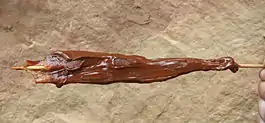
The United States and Canada have seen an increase in the popularity of bacon and bacon-related recipes, dubbed "bacon mania". The sale of bacon in the US has increased significantly since 2011. Sales climbed 9.5% in 2013, making it an all-time high of nearly $4 billion in US. In a survey conducted by Smithfield, 65% of Americans would support bacon as their "national food".[34] Dishes such as bacon explosion, chicken fried bacon, and chocolate-covered bacon have been popularised over the internet,[35] as has the use of candied bacon. Recipes spread quickly through both countries' national media, culinary blogs, and YouTube.[36][37] Restaurants have organised and are organising bacon and beer tasting nights,[38] The New York Times reported on bacon infused with Irish whiskey used for Saint Patrick's Day cocktails,[39] and celebrity chef Bobby Flay has endorsed a "Bacon of the Month" club online, in print,[40] and on national television.[41]
Commentators explain this surging interest in bacon by reference to what they deem American cultural characteristics. Sarah Hepola, in a 2008 article in Salon.com, suggests a number of reasons, one of them being that eating bacon in the modern, health-conscious world is an act of rebellion: "Loving bacon is like shoving a middle finger in the face of all that is healthy and holy while an unfiltered cigarette smoulders between your lips."[42] She also suggests bacon is sexy (with a reference to Sarah Katherine Lewis' book Sex and Bacon), kitsch, and funny. Hepola concludes by saying that "Bacon is American".
Alison Cook, writing in the Houston Chronicle, argues the case of bacon's American citizenship by referring to historical and geographical uses of bacon.[36] Early American literature echoes the sentiment—in Ebenezer Cooke's 1708 poem The Sot-Weed Factor, a satire of life in early colonial America, the narrator already complains that practically all the food in America was bacon-infused.[43]
As of December 2016, the U.S. national frozen pork belly inventory totaled 17.8 million lb (8.1 million kg), the lowest level in 50 years.[44]
Bacon dishes
.jpg.webp)
Bacon dishes include bacon and eggs, bacon, lettuce, and tomato (BLT) sandwiches, Cobb salad, and various bacon-wrapped foods, such as scallops, shrimp,[45][46][47] and asparagus. Recently invented bacon dishes include chicken fried bacon, chocolate covered bacon, bacon jerky, bacon ice cream and the bacon explosion. Tatws Pum Munud is a traditional Welsh stew, made with sliced potatoes, vegetables and smoked bacon. Bacon jam and bacon marmalade are also commercially available.
In the US and Europe, bacon is commonly used as a condiment or topping on other foods, often in the form of bacon bits. Streaky bacon is more commonly used as a topping in the US on such items as pizza, salads, sandwiches, hamburgers, baked potatoes, hot dogs, and soups. In the US, sliced smoked back bacon is used less frequently than the streaky variety, but can sometimes be found on pizza, salads, and omelettes.
Bacon is also used in adaptations of dishes; for example, bacon-wrapped meatloaf,[48] and can be mixed in with green beans[49] or served sautéed over spinach.
Bacon fat

Bacon fat liquefies and becomes drippings when it is heated. Once cool, it firms into a form of lard. Bacon fat is flavourful and is used for various cooking purposes. Traditionally, bacon grease is saved in British and southern US cuisine, and used as a base for cooking and as an all-purpose flavouring, for everything from gravy to cornbread[50] to salad dressing.[51]
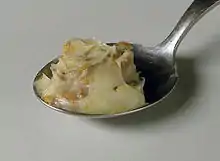
In Germany, Griebenschmalz is a popular spread made from bacon lard.
Bacon is often used for a cooking technique called barding consisting of laying or wrapping strips of bacon or other fats over a roast to provide additional fat to a lean piece of meat. It is often used for roast game birds, and is a traditional method of preparing beef filet mignon, which is wrapped in strips of bacon before cooking. The bacon itself may afterwards be discarded or served to eat, like cracklings. It may also be cut into lardons.
One teaspoon (4 g or 0.14 oz) of bacon grease has 38 calories (40 kJ/g).[52] It is composed almost completely of fat, with very little additional nutritional value. Bacon fat is roughly 40% saturated.[52] Despite the disputed health risks of excessive bacon grease consumption, it remains popular in the cuisine of the American South.[53]
Nutrients
One 10-g slice of cooked side bacon contains 4.5 g of fat, 3.0 g of protein, and 205 mg of sodium.[54] The fat, protein, and sodium content varies depending on the cut and cooking method.
68% of the food energy of bacon comes from fat, almost half of which is saturated.[55] A serving of three slices of bacon contains 30 milligrams of cholesterol (0.1%).[55][56]
Health concerns
Studies have consistently found the consumption of processed meat to be linked to increased mortality, and to an increased risk of developing a number of serious health conditions including cancer, cardiovascular disease and type 2 diabetes.[57][58] Although as of 2017 these links have not been definitely established as causal, they are likely to be.[58]
Bacon can contain nitrites, which can form carcinogenic nitrosamines. In the United States, sodium nitrite cannot exceed certain levels in bacon. Vitamin C (ascorbate) or sodium erythorbate can be added to bacon, which greatly reduces the formation of nitrosamines. Vitamin E (tocopherol) also reduces nitrosamine levels. Bacon fried at higher temperatures potentially has more nitrosamines than bacon fried at lower temperatures.[59]
According to the World Health Organization, regular consumption of processed meats such as bacon increases the likelihood of developing colorectal cancers by 18%.[60]
Alternatives
Several alternatives to and substitutes for bacon have been developed for those who cannot or prefer not to eat standard pork bacon, including beef, chicken, turkey, bison, and coconut bacon.
Turkey bacon

Turkey bacon is an alternative to bacon.[1][61] People may choose turkey bacon over real bacon due to health benefits, religious laws, or other reasons.[61] It is lower in fat and food energy than bacon,[1][61] but may be used in a similar manner (such as in a BLT sandwich).[61]
The meat for turkey bacon comes from the whole turkey and can be cured or uncured, smoked, chopped, and reformed into strips that resemble bacon.[1] Turkey bacon is cooked by pan-frying.[61] Cured turkey bacon made from dark meat can be less than 10% fat.[62] The low fat content of turkey bacon means it does not shrink while being cooked and has a tendency to stick to the pan.[62]
Macon
Macon is another alternative to bacon, produced by curing cuts of mutton in a manner similar to the production of pork bacon.[63] Historically produced in Scotland, it was introduced across Britain during World War II as a consequence of rationing.[64][65] It is today available as an alternative to bacon, produced for the Muslim market and sold at halal butchers; it is largely similar in appearance to pork bacon except for the darker colour.[66]
Vegetarian bacon
Vegetarian bacon, also referred to as facon, veggie bacon, or vacon, is a product marketed as a bacon alternative.[67] It has no cholesterol, is low in fat, and contains large amounts of protein and fibre.[67] Two slices contain about 310 kilojoules (74 kcal).[67] Vegetarian bacon is usually made from marinated strips of textured soy protein or tempeh.
Reception
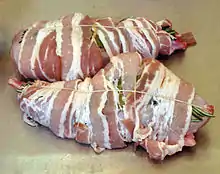
Everything Tastes Better with Bacon, a book by Sara Perry, is a cookbook that compliments bacon's many uses in cooking.[68]
On the other hand, as with most meat products, producers of bacon have received heavy criticism for how their pigs are treated. Many petitions and protests have been made trying to raise awareness and change how producers treat their pigs. Many of these protests have turned out successful: for example, following NBC News's report of an undercover investigation of an abusive pig farm, Tyson Foods terminated their contract with the pig farm.[69] Similar to NBC's investigation, The Humane Society of the United States (HSUS) investigated Seaboard Foods, one of the pig breeding facilities that supply Walmart.[70] According to HSUS, the pigs were treated poorly and abused. Walmart spokesperson Diana Gee said, "As soon as we were made aware of the allegations, we immediately reached out to Seaboard to begin investigating the issue ... Pending our review, we will take any action necessary." Petitions also exist that oppose poor treatment of pigs, many of which state that the current treatment of pigs in factories is cruel and unethical.[71][72]
Bacon-flavoured products
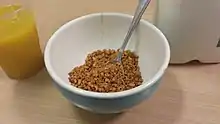
The popularity of bacon in the United States has given rise to a number of commercial products that promise to add bacon flavouring without the labour involved in cooking it or the perceived negative qualities of bacon.
Bacon bits
Bacon bits are a frequently used topping on salad or potatoes, and a common element of salad bars.[1] They are usually salted. Bacon bits are made from small, crumbled pieces of bacon;[1] in commercial plants they are cooked in continuous microwave ovens. Similar products are made from ham or turkey, and analogues are made from textured vegetable protein, artificially flavoured to resemble bacon.[73]
Other bacon-flavoured products
There is also a wide range of other bacon-flavoured products, including a bacon-flavoured salt (Bacon Salt),[1][74] Baconnaise (a bacon-flavoured mayonnaise),[1][75] Bacon Grill (a tinned meat, similar to Spam) and bacon ice cream.
See also
|
|
|
References
- Filippone, Peggy. "What is bacon". thespruce.com. Retrieved 30 April 2017.
- "Bacon". OED Online. Oxford University Press. 1989. 50016435.
- Hiskey, Daven (30 August 2010). "Origin of the Word "Bacon"". Today I Found Out. Retrieved 4 February 2014.
- F. Kluge, Etymological dictionary of the German language s.v. Bauch.
- "Eat cheap but well! Make a tasty beef in beer". Today. NBC News. 30 April 2009. Archived from the original on 3 May 2009. Retrieved 13 May 2009.
- "Health and You". New Straits Times. 12 May 2009. Archived from the original on 27 June 2009. Retrieved 13 May 2009.
- "Bacon Cuts". James Whelan Butchers. Retrieved 3 January 2014.
- Randolph, Mary; Karen Hess (1984). The Virginia Housewife. University of South Carolina Press. pp. 18–19. ISBN 978-0-87249-423-7.
- Sarah F. McMahon, "Gender, Dietary Decisions, and Food Technology," in McGaw, Judith A. (1994). Early American technology: making and doing things from the colonial era to 1850. University of North Carolina Press. pp. 186–89. ISBN 978-0-8078-4484-7.
- "Bacon Varieties". The Bacon Page. Archived from the original on 3 September 2014. Retrieved 9 February 2014.
- "USDA Food Safety and Inspection Service: Glossary B". Food Safety and Inspection Service. Archived from the original on 3 May 2009. Retrieved 5 May 2009.
- Hui, Yiu H.; Bruinsma, L. Bernard; Gorham, J. Richard (2002). Food Plant Sanitation. CRC Press. p. 605. ISBN 978-0-8247-0793-4. Retrieved 5 May 2009.
- "Kiwi Bacon – All about bacon". Kiwi Bacon. Archived from the original on 22 February 2014. Retrieved 8 February 2014.
- "A Guide To Traditional British Back Bacon". The English Breakfast Society. 4 January 2014. Retrieved 8 February 2014.
- "Information and Statistics 2005" (PDF). Danish Bacon Company. 30 March 2005. Archived from the original (PDF) on 30 January 2006. Cite journal requires
|journal=(help) - "Food – Glossary – 'C' – 'Collar'". BBC. Archived from the original on 23 May 2006. Retrieved 2 January 2014.
- "Jowl Bacon". Zingerman's. Archived from the original on 22 February 2014. Retrieved 8 February 2014.
- "bacon rind – definition of bacon rind by the Free Online Dictionary, Thesaurus and Encyclopedia". Farlex, Inc. Retrieved 8 February 2014.
- "The Full English Breakfast". 4 January 2014. English Breakfast Society. Retrieved 8 February 2014.
- "Food Service – Bacon". KR Castlemaine. Archived from the original on 1 October 2009. Retrieved 2 January 2014.
- Canadian Oxford Dictionary, 2nd ed. (2004).
- "Japanese Meaning or Translation of – 'bacon'". Bdword. Retrieved 9 February 2014.
- "伊藤ハム | 商品情報 |". Itoham.co.jp. Archived from the original on 2 January 2014. Retrieved 2 January 2014.
- "How to make the perfect full English breakfast". 25 June 2015.
- "The Full English Breakfast Hops the Pond". Wall Street Journal. Retrieved 21 February 2018
- "What's the difference between the different bacon cuts?", 14 July 2017, www.puddledub.co.uk/blog.
- "What are Bacon Joints?", Wiltshire Bacon Co.
- Cloake, Felicity (7 March 2012). "How to cook the perfect bacon sandwich". The Guardian. Retrieved 15 January 2015.
- "Bacon sandwich really does cure a hangover". The Daily Telegraph. 7 April 2009. Archived from the original on 7 January 2010. Retrieved 7 February 2019.
- Weinzweig, Ari (24 July 2008). "Canadian Peameal Bacon". Zingerman's Roadhouse. Archived from the original on 25 February 2009.
- R. W. Apple Jr. The Smoky Trail To a Great Bacon 16 February 2000 The New York Times
- Hog, Boss. "Whiskey Maple Glazed Slab Bacon". Bacon Today. Archived from the original on 22 February 2014. Retrieved 9 February 2014.
- The 'uncured' bacon illusion: It’s actually cured, and it's not better for you.
- Passy, Charles (11 February 2014). "Bacon sales sizzle to all-time high". Market Watch. Retrieved 11 February 2014.
- "Get Your BBQ On: Bacon-Infused Webinar Sheds Light on Social Media Marketing Viral Marketing Sensation BBQ Addicts Join Marketbright for a Free Webinar on Marketing 2.0". Marketwire. 24 March 2009. Archived from the original on 26 April 2009. Cite journal requires
|journal=(help) - Cook, Alison (5 March 2009). "It's a 'we love bacon' world: We're just lucky to be living—and dining—in it". Houston Chronicle.
- "Candied Bacon Martini". Los Angeles Times.
- "Bacon and Beer Tasting at Jimmy's No. 43". New York Barfly. 4 November 2008. Archived from the original on 20 April 2009. Retrieved 15 March 2009.
- Miles, Jonathan (13 March 2009). "Wear the Green but Don't Drink It". The New York Times. Archived from the original on 17 April 2009.
- "Bacon of the Month Club". The Grateful Palate. Archived from the original on 22 March 2009. Retrieved 15 March 2009.
- "Food Gifts That Keep on Giving: From Utensils To Treats, Bobby Flay Likes To Give (Or Receive) These Presents". CBS News. 13 December 2007. Archived from the original on 8 May 2009.
- Hepola, Sarah (7 July 2008). "Bacon mania: Why are Americans so batty for bacon? It's delicious, it's decadent – and it's also a fashion statement". Salon.com.
- Kay, Arthur (1998). "Ebenezer Cooke: The Sot-Weed Factor". Renascence editions. Archived from the original on 9 May 2008.
- "Nation's bacon reserves hit 50-year low as prices rise". USA TODAY. Retrieved 1 February 2017.
- Siegel, Helene (1997). Totally Shrimp Cookbook. Celestial Arts. p. 11. ISBN 978-0-89087-823-1.
- Wise, Jane E. (2005). The Culinary Guide for MSPI. Milk Soy Protein Intolerance. p. 7. ISBN 978-0-9764023-0-5.
- Daley, Bill (11 March 2001). "Chengdu Cuisine of China". Hartford Courant. p. 10.
- "Recipe Bacon wrapped meatloaf". WKRG Mobile, Alabama. 10 April 2008. Archived from the original on 10 June 2008. Retrieved 2 January 2014.
- "Recipe Green Beans with Bacon". WKRG Mobile, Alabama. 28 July 2008. Archived from the original on 10 July 2009. Retrieved 2 January 2014.
- Rombauer, Irma; Rombauer Becker, Marion (1964). "Pan Gravy". The Joy of Cooking. Bobbs-Merrill Company. p. 322. ISBN 978-0-02-604570-4.
- Brown, Alton. "Bacon Vinaigrette with Grilled Radicchio". Archived from the original on 13 February 2008. Retrieved 13 January 2008.
- "Nutritional Summary for Animal fat, bacon grease". nutritiondata.com. Retrieved 5 May 2009.
- McDaniel, Rob. "From the Chef: Balance Essential to Southern Food, not just Bacon Drippings". SpringHouse at Crossroads. Retrieved 9 February 2014.
- "USDA Branded Food Products Database – Thick Cut Bacon". United States Department of Agriculture. Retrieved 29 March 2019.
- Magee, Elaine. "Can Bacon Be Part of a Healthy Diet?". WebMD. Retrieved 5 January 2014.
- Jacques, Renee (12 November 2013). "9 Unfortunate Truths About Juicy, Scrumptious Bacon". The Huffington Post.
- Rohrmann S, Linseisen J (August 2016). "Processed meat: the real villain?" (PDF). Proc Nutr Soc (Review). 75 (3): 233–41. doi:10.1017/S0029665115004255. PMID 26621069.
- Wolk A (February 2017). "Potential health hazards of eating red meat". J. Intern. Med. (Review). 281 (2): 106–122. doi:10.1111/joim.12543. PMID 27597529. S2CID 24130100.
- "Bacon and Food Safety". usda.gov. Retrieved 18 October 2020.
- Gallagher, James (26 October 2015). "Processed meats do cause cancer – WHO". BBC News. Retrieved 27 October 2015.
- Gold, Amanda (22 October 2008). "One turkey bacon stands out in the flock". San Francisco Chronicle. Retrieved 13 May 2009.
- "Turkey Bacon Wins Support as Good Meat at Breakfast". Deseret News. 23 January 1991.
- Shephard, Sue (2006). Pickled, Potted, and Canned: How the Art and Science of Food Preserving Changed the World. Simon and Schuster. p. 73. ISBN 978-0-7432-5553-0.
- "Footnote in Time Magazine mentions wartime use".
- "23.1.40". 23 January 2010.
- Booley, Ashraf. "Macon: Bacon's Underrated Cousin". Woolworth's Taste. Archived from the original on 28 November 2014. Retrieved 2 March 2015.
- "Vegetarian Bacon". Archived from the original on 25 March 2012. Retrieved 18 June 2011.
- Crooks, Laura (7 August 2002). "Let bacon add a little sizzle to your meal". The Spokesman-Review. Cowles Publishing Company. p. D1. Archived from the original on 6 September 2002.
- Schecter, Anna; Alba, Monica; Perez, Lindsay (20 November 2013). "Tyson Foods dumps pig farm after NBC shows company video of alleged abuse". NBC News. Archived from the original on 25 January 2014. Retrieved 3 January 2014.
- Zelman, Joanna (1 February 2012). "Seaboard Corporation Pig Treatment Challenged By Humane Society Investigation (GRAPHIC VIDEO)". The Huffington Post.
- "Clarified – What are gestation crates?". CNN. 6 June 2012. Retrieved 9 February 2014.
- "Undercover Investigations: Exposing Animal Abuse". Mercy for Animals. Retrieved 9 February 2014.
- "Textured Vegetable Protein". Diversified Foods Inc. Archived from the original on 23 July 2008. Retrieved 15 March 2009.
- Neal Karlinsky (21 April 2009). "'Bacontrepreneurs' Building Bacon Empire". ABC News. Archived from the original on 25 March 2016.
- "J & D's – Everything Should Taste Like Bacon". J & D's. Archived from the original on 2 March 2009. Retrieved 15 March 2009.
- Anderson, H. J., "Bacon Production" in Encyclopedia of Meat Sciences, Editors M. Dikeman, Carrick Devine, 2004, Academic Press, ISBN 0080924441, 9780080924441, google books
External links
| Look up bacon in Wiktionary, the free dictionary. |
| Wikimedia Commons has media related to Bacon. |
| Wikiquote has quotations related to: Bacon |
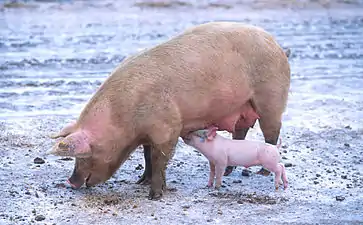
.jpg.webp)
